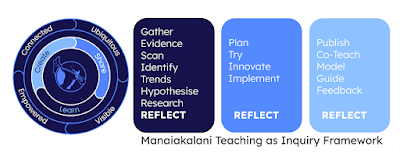I am a firm believer when it comes to the effectiveness of professional learning development (PLD) is that when a team walks the journey together it becomes a journey that has life. PLD done alone or in isolation is much harder to keep going as there is no one to bounce ideas off, share successes, problem solve when it doesn't quite go to plan or to keep you on track.
With new team members there is always the challenge of getting everyone on the same page. With this thinking in mind at the end of Term 1 I got my team together and suggested the idea of an 'in house' literacy PLD day. In my team leader role I spend time in each room coaching and supporting my team in their literacy practice. This traditionally was always on a 1:1 basis which meant I wasn't using my time effectively and ended up repeating myself a lot. We all agreed to use a CRT day, and despite the logistical nightmare of ensuring everyone was released on the same day, we went ahead with the full support of our management team.
With a wide range of teaching experience in my team I chose to start at the beginning by looking at how we are using the data to inform our planning through to the scaffolds and words we are using in front of our tamariki. You learn better when you physically do the task so I asked my team to see the learning through the eyes of our learners by taking them through the lessons. This provided us with clarity, a shared understanding of what procedural writing looked like and how to use the strategies I was sharing in context. I would like to take this opportunity to thank my team for approaching the day with open minds and a willingness to actively participate.
The DLO below shows what we covered. Some links are restricted to keep student anonymity. The aim of the day was to set us up for success in Term 2 by leading a guided planning session for the first three weeks of literacy.
As with anything you try for the first time there is always an element of risk. I didn't want to undervalue what my team was bringing to the table but I did want to streamline our process by helping everyone make connections to our 'why' as well as our 'how'.
At the end of the day I asked my team what their takeaways were. Their anonymous responses are below:
Teacher A
- How explicit things are if you show and tell - you learn by doing it
- Foundational basics are important
- Refer back to the data
Teacher B
- How to unpack a text type - going back to basics
- Tapping into prior knowledge and data
- Gallery walk
- Working in pairs
- The power of talk
Teacher C
- Prior knowledge shows me what the students already know
- How to model explicitly eg- time connectives
- How we can combine reading and writing together - integration
- What to focus on when you teach a text type
- How to use the data
- Going back to basics
- Integration of planning
- Clarity in planning transfers to the lesson
- How to use the data
As you can see the responses were different as we connect best to what resonates with us and what we needed to learn or be reminded of. Going forward as a team we have decided to continue with this type of PLD, only this time covered in our team meetings. It won't always be a literacy focus and it won't always be led by me. We have a great skills set in our team that we can tap into, after all we learn better when we learn together.













